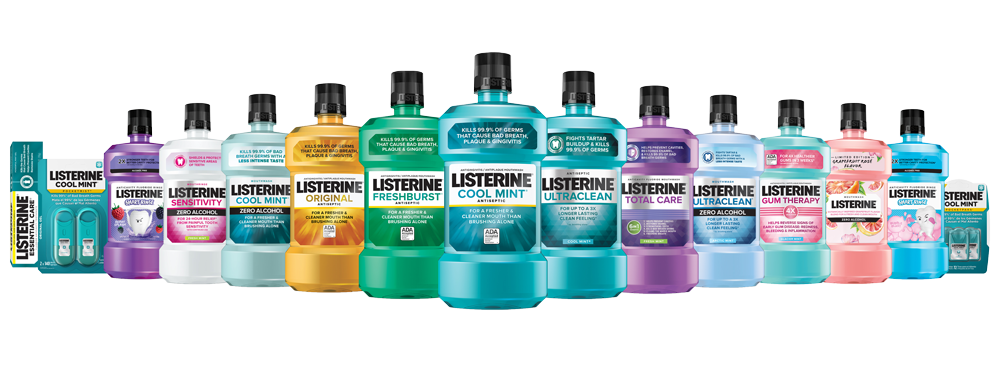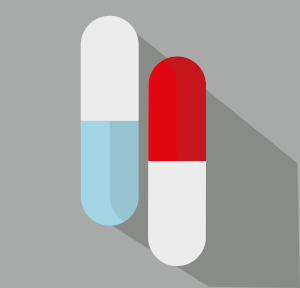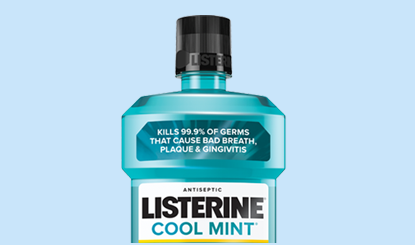

Licensed professionals can receive the latest Listerine clinical information and patient resources.

ANTIMICROBIALS
(ESSENTIAL OILS IN LISTERINE® ANTISEPTIC) VS ANTIBIOTICS:
IMPORTANT CHARACTERISTICS AND DIFFERENCES
BACTERIAL SPECIES IN THE MOUTH
200-300 DIFFERENT BACTERIAL SPECIES AT ANY GIVEN TIME.1,2
Dental plaque is very heterogeneous, with one area of the mouth potentially hosting a variety of bacterial species different from those in another area. LISTERINE® Antiseptic acts against all types of bacterial species in the mouth. It also comes without the threat of emerging bacterial resistance.1, 3-5
ANTIMICROBIALS VS ANTIBIOTICS3,4, 6-9
It can be easy to confuse a therapeutic antimicrobial with an antibiotic; this confusion can raise concerns over the safety and efficacy of twice-daily use of an antimicrobial mouthrinse.
An antimicrobial mouthrinse is not an antibiotic, and although both kill bacteria, it is important to distinguish between antimicrobials and antibiotics.
(Essential oils in LISTERINE® Antiseptic)
ANTIBIOTICS

Antibiotics can be bacteriostatic (prevent growth of bacteria) and/or bactericidal (kill bacteria). In fact, most antibiotics are potentially both.
Antibiotics are very effective at killing bacteria that are susceptible to that particular antibiotic; however, with defined activity and mechanisms of action, antibiotics are not generally as broadly effective across bacteria species as antimicrobials.
ANTIBIOTIC RESISTANCE8,9
Antibiotics are very effective, important drugs; but frequent use of antibiotics can lead to resistance conferred by gene mutations in bacteria.
Because the genetic material responsible for antibiotic resistance generally exists outside the bacteria’s genes in a stand-alone portion of DNA, this resistance can transfer between and within species of bacteria. This ability to transfer genetic material from one bacterium to another results in the spread of antibiotic resistance.
ANTIMICROBIALS (ESSENTIAL OILS IN LISTERINE® ANTISEPTIC)1
The fixed combination of essential oils in LISTERINE® Antiseptic are among the antimicrobials with the broadest spectrum of activity in the mouth—without the threat of building bacterial resistance.10
Antimicrobials have non-specific activity, which makes it difficult for bacteria to become resistant to antimicrobial treatment. The fixed combination of essential oils in LISTERINE Antiseptic rapidly disrupts the bacterial cell wall, and works through:1
- Protein denaturation
- Bacterial enzyme activity alteration
- Bacterial endotoxin extraction
- Increased bacterial regeneration time
There is no scientific evidence that the fixed combination of essential oils in LISTERINE® Antiseptic has led to bacterial resistance.1 LISTERINE® Antiseptic has been used for over a century, with billions of doses and millions of users.3 In two 6 month clinical studies,11,12 there has been no evidence of the emergence of antimicrobial-resistant pathogens.
LISTERINE® ANTISEPTIC ACTS AGAINST
ALL TYPES OF SPECIES OF BACTERIA IN THE MOUTH1,3,4
LISTERINE kills 99.9% of bacteria that cause bad breath, plaque, and gingivitis within 30 seconds.6,7,13-16 The early-colonizing bacterial species repopulate within minutes of brushing and rinsing. These beneficial bacteria grow and rebound faster than the late-colonizing harmful bacteria.1
The benefit of antimicrobials is that they reduce the overall bacterial plaque load over time. LISTERINE® Antiseptic has an established safety profile, thins the biofilm, and shifts the oral microbiome to a healthier state, without an observed development of bacterial resistance.1
Use product as directed.
LISTERINE® Antiseptic is not intended to replace an antibiotic.
References: 1. Darby ML, Asadoorian J, DePaola LG, Gurenlian JR, Spolarich AE; for the American Dental Hygienists' Association. 2007 Journal of Dental Hygiene [special supplement to Access magazine], 2. Loesche WJ. Chapter 99. Microbiology of dental decay and periodontal disease. In: Baron S, ed. Medical Microbiology, 4th ed. Galveston, TX: University of Texas Medical Branch; 1996. Downloaded online at: https://www.ncbi.nlm.nih.gov/books/NBK8259. Accessed January 25, 2022. 3. Data on file. Johnson & Johnson Consumer Inc. 4. Food and Drug Administration. Oral health care drug products for over-the-counter human use; antigingivitis/antiplaque drug products; establishment of a monograph; proposed rules. Part III. Fed Regist. 2003;68(103):32232-32287. 5. Aas JA, Paster BJ, Stokes LN, Olsen I, Dewhirst FE. Defining the normal bacterial flora of the oral cavity. J Clin Microbiol. 2005;43(11):5721-5732. 6. Fine DH, Letizia J, Mandel ID. The effect of rinsing with LISTERINE® Antiseptic on the properties of developing dental plaque. J Clin Periodontol. 1985;12:660-666. 7. Kubert D, Rubin M, Barnett ML, Vincent JW. Antiseptic mouthrinse-induced microbial cell surface alterations. Am J Dent. 1993;6(6):277-9. 8. NPS MedicineWise website. Antibiotics, explained: how do antibiotics work? https://www.nps.org.au/consumers/antibiotics-explained Last reviewed: December 18, 2019. Accessed January 25, 2022. 9. Hawkey PM. The origins and molecular basis of antibiotic resistance. BMJ. 1998;317:657-660. 10. Seow YX, Yeo CR, Chung HL, Yuk H-G. Plant essential oils as active antimicrobial agents. Crit Rev Food Sci Nutr. 2014;54(5):625-644. 11. Walker C, Clark W, Wheeler T, Lamm R. Evaluation of microbial shifts in supragingival plaque following long-term use of an oral antiseptic mouthrinse. J Dent Res. 1989;68:412. 12. Minah GE, DePaola LG, Overholser CD, et al. Effects of 6 months use of an antiseptic mouthrinse on supragingival dental plaque microflora. J Clin Periodontol. 1989;16(6):347-52. 13. Pan P, Barnett ML, Coelho J, Brogdon C, Finnegan MB. Determination of the in situ bactericidal activity of an essential oil mouthrinse using a vital stain method. J Clin Periodontal. 2000;27:256-261. 14. Pitts G, Pianotti R, Feary TW, McGuiness J, Masura T. The in vivo effects of an antiseptic mouthwash on odor-producing microorganisms. J Dent Res. 1981;60(ll):189-1896. 15. Pitts G, Brogdon L, Hu L, Masurat T, Pianotti R, Schuman P. Mechanism of action of an antiseptic, anti-odor mouthwash. J Dent Res. 1983;62:738-742. 16. Ilg D, McGuire JA, Mordas CJ, Queiroz D, Fourre T, Santos SL. In vitro efficacy of an alcohol-free essential oil containing mouthrinse [abstract]. In: Proceedings from the 2nd North American/Global Dental Hygiene Research Conference; 2011 Oct 20-22; Bethesda, MD. Chicago (IL): Journal of Dental Hygiene', 2011. Abstract 27. 17. Swango PA. Regular use of antimicrobial mouthrinses can effectively augment the benefits of oral prophylaxis and oral hygiene instructions at 6-month recall intervals in reducing the occurrence of dental plaque and gingivitis. J Evid Based Dent Pract. 2012;12(2):87-9.
Explore the new 12-week study of LISTERINE® Antiseptic and Flossing




All Fields required, unless otherwise indicated
Personal Information
Step 1
Will be used as your user name
By submitting your information above, you agree that the information you provide will be governed by our site's Privacy Policy.